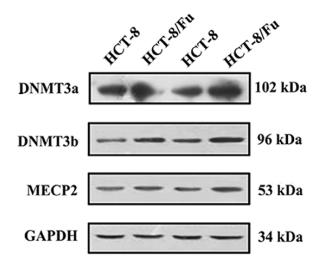DNMT3B Antibody - #AF5493
| Product: | DNMT3B Antibody |
| Catalog: | AF5493 |
| Description: | Rabbit polyclonal antibody to DNMT3B |
| Application: | WB IHC IF/ICC |
| Cited expt.: | WB |
| Reactivity: | Human, Mouse, Rat |
| Prediction: | Bovine, Horse, Sheep, Rabbit |
| Mol.Wt.: | 97 kDa; 96kD(Calculated). |
| Uniprot: | Q9UBC3 |
| RRID: | AB_2837973 |
Product Info
*The optimal dilutions should be determined by the end user. For optimal experimental results, antibody reuse is not recommended.
*Tips:
WB: For western blot detection of denatured protein samples. IHC: For immunohistochemical detection of paraffin sections (IHC-p) or frozen sections (IHC-f) of tissue samples. IF/ICC: For immunofluorescence detection of cell samples. ELISA(peptide): For ELISA detection of antigenic peptide.
Cite Format: Affinity Biosciences Cat# AF5493, RRID:AB_2837973.
Fold/Unfold
Cytosine 5methyltransferase 3B; DNA; DNA (cytosine 5) methyltransferase 3 beta; DNA (cytosine 5)-methyltransferase 3B; DNA (cytosine-5)-methyltransferase 3B; DNA methyltransferase HsaIIIB; DNA MTase HsaIIIB; DNM3B_HUMAN; Dnmt3b; EC 2.1.1.37; ICF; ICF1; M.HsaIIIB; MGC124407; RP23-89H14.3;
Immunogens
A synthesized peptide derived from human DNMT3B, corresponding to a region within N-terminal amino acids.
Ubiquitous; highly expressed in fetal liver, heart, kidney, placenta, and at lower levels in spleen, colon, brain, liver, small intestine, lung, peripheral blood mononuclear cells, and skeletal muscle. Isoform 1 is expressed in all tissues except brain, skeletal muscle and PBMC, 3 is ubiquitous, 4 is expressed in all tissues except brain, skeletal muscle, lung and prostate and 5 is detectable only in testis and at very low level in brain and prostate.
- Q9UBC3 DNM3B_HUMAN:
- Protein BLAST With
- NCBI/
- ExPASy/
- Uniprot
MKGDTRHLNGEEDAGGREDSILVNGACSDQSSDSPPILEAIRTPEIRGRRSSSRLSKREVSSLLSYTQDLTGDGDGEDGDGSDTPVMPKLFRETRTRSESPAVRTRNNNSVSSRERHRPSPRSTRGRQGRNHVDESPVEFPATRSLRRRATASAGTPWPSPPSSYLTIDLTDDTEDTHGTPQSSSTPYARLAQDSQQGGMESPQVEADSGDGDSSEYQDGKEFGIGDLVWGKIKGFSWWPAMVVSWKATSKRQAMSGMRWVQWFGDGKFSEVSADKLVALGLFSQHFNLATFNKLVSYRKAMYHALEKARVRAGKTFPSSPGDSLEDQLKPMLEWAHGGFKPTGIEGLKPNNTQPVVNKSKVRRAGSRKLESRKYENKTRRRTADDSATSDYCPAPKRLKTNCYNNGKDRGDEDQSREQMASDVANNKSSLEDGCLSCGRKNPVSFHPLFEGGLCQTCRDRFLELFYMYDDDGYQSYCTVCCEGRELLLCSNTSCCRCFCVECLEVLVGTGTAAEAKLQEPWSCYMCLPQRCHGVLRRRKDWNVRLQAFFTSDTGLEYEAPKLYPAIPAARRRPIRVLSLFDGIATGYLVLKELGIKVGKYVASEVCEESIAVGTVKHEGNIKYVNDVRNITKKNIEEWGPFDLVIGGSPCNDLSNVNPARKGLYEGTGRLFFEFYHLLNYSRPKEGDDRPFFWMFENVVAMKVGDKRDISRFLECNPVMIDAIKVSAAHRARYFWGNLPGMNRPVIASKNDKLELQDCLEYNRIAKLKKVQTITTKSNSIKQGKNQLFPVVMNGKEDVLWCTELERIFGFPVHYTDVSNMGRGARQKLLGRSWSVPVIRHLFAPLKDYFACE
Predictions
Score>80(red) has high confidence and is suggested to be used for WB detection. *The prediction model is mainly based on the alignment of immunogen sequences, the results are for reference only, not as the basis of quality assurance.
High(score>80) Medium(80>score>50) Low(score<50) No confidence
Research Backgrounds
Required for genome-wide de novo methylation and is essential for the establishment of DNA methylation patterns during development. DNA methylation is coordinated with methylation of histones. May preferentially methylates nucleosomal DNA within the nucleosome core region. May function as transcriptional co-repressor by associating with CBX4 and independently of DNA methylation. Seems to be involved in gene silencing (By similarity). In association with DNMT1 and via the recruitment of CTCFL/BORIS, involved in activation of BAG1 gene expression by modulating dimethylation of promoter histone H3 at H3K4 and H3K9. Isoforms 4 and 5 are probably not functional due to the deletion of two conserved methyltransferase motifs. Functions as a transcriptional corepressor by associating with ZHX1. Required for DUX4 silencing in somatic cells.
Sumoylated.
Citrullinated by PADI4.
Nucleus.
Ubiquitous; highly expressed in fetal liver, heart, kidney, placenta, and at lower levels in spleen, colon, brain, liver, small intestine, lung, peripheral blood mononuclear cells, and skeletal muscle. Isoform 1 is expressed in all tissues except brain, skeletal muscle and PBMC, 3 is ubiquitous, 4 is expressed in all tissues except brain, skeletal muscle, lung and prostate and 5 is detectable only in testis and at very low level in brain and prostate.
The PWWP domain is essential for targeting to pericentric heterochromatin.
Belongs to the class I-like SAM-binding methyltransferase superfamily. C5-methyltransferase family.
Research Fields
· Human Diseases > Cancers: Overview > MicroRNAs in cancer.
· Metabolism > Amino acid metabolism > Cysteine and methionine metabolism.
· Metabolism > Global and overview maps > Metabolic pathways.
References
Application: WB Species: Mouse Sample: GCs
Application: WB Species: rat Sample: ovaries
Application: WB Species: human Sample: HCT-8 and HCT-8/Fu cells
Application: WB Species: Rat Sample:
Restrictive clause
Affinity Biosciences tests all products strictly. Citations are provided as a resource for additional applications that have not been validated by Affinity Biosciences. Please choose the appropriate format for each application and consult Materials and Methods sections for additional details about the use of any product in these publications.
For Research Use Only.
Not for use in diagnostic or therapeutic procedures. Not for resale. Not for distribution without written consent. Affinity Biosciences will not be held responsible for patent infringement or other violations that may occur with the use of our products. Affinity Biosciences, Affinity Biosciences Logo and all other trademarks are the property of Affinity Biosciences LTD.









